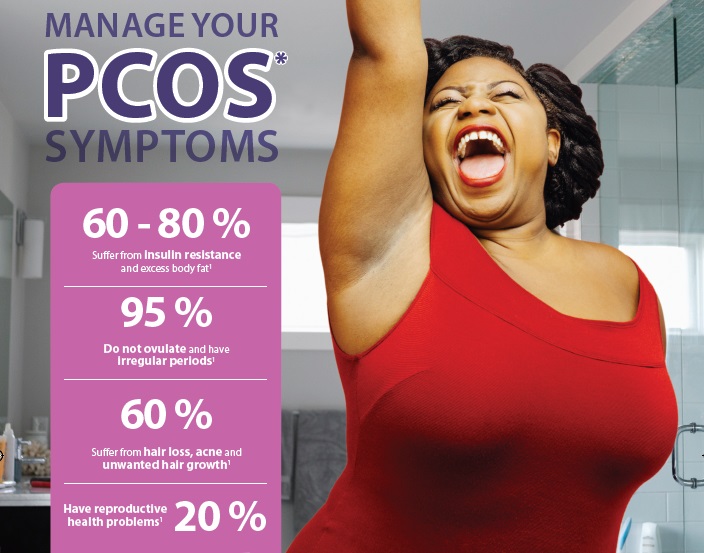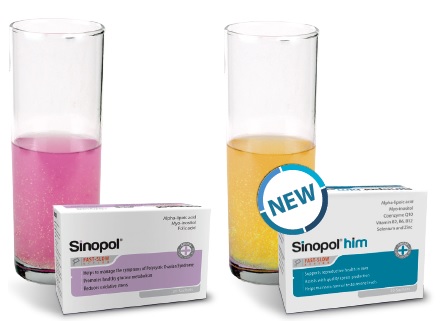PCOS – Polycystic Ovarian Syndrome


READ FURTHER TO FIND OUT MORE ABOUT PCOS AND HOW SINOPOL® HELPS TO CORRECT THE HORMONAL AND METABOLIC IMBALANCES IN WOMEN STRUGGLING WITH POLYCYSTIC OVARIAN SYNDROME (PCOS)2
Back to top
CONTENTS
Back to top
WHAT IS POLYCYSTIC OVARIAN SYNDROME (PCOS)?
PCOS is a hormonal disorder among women of reproductive age that involves hormonal imbalances and metabolic abnormalities such as insulin resistance, dyslipidaemia (high levels of cholesterol in the blood which increases the risk of clogged arteries, heart attacks or stroke), hypertension (high blood pressure) and excess weight which significantly increase the risk of infertility, type 2 diabetes, cardiovascular disease and affect quality of life.3

Back to top
WHAT ARE THE SYMPTOMS AND SIGNS OF PCOS?
PCOS may present with different symptoms at different stages of a woman’s life.5 Common symptoms and signs of PCOS are:
- Menstrual irregularities or no periods at all, due to not ovulating5
- Several ovarian cysts5
- Unwanted hair growth on the upper lip, face, arms, back, chest, thumbs, toes or abdomen (hirsutism), due to an excess of androgen hormones (male hormones)5,6
- Thinning hair on the head6
- Acne5
- Insulin resistance is a complex condition where muscles, fat, and liver do not respond well to insulin and are unable to use glucose from your blood for energy. High insulin levels in the blood stream cause hormonal imbalances which can lead to excess androgens, no ovulation and therefore reproductive health issues. Further problems may include obesity, high blood pressure and cholesterol and type 2 diabetes.5,7
Back to top
WHAT CAUSES PCOS?
The exact cause is unknown, but it is considered to be caused by hormonal imbalances. Up to 80 % of women with PCOS are insulin resistant, which plays a major role in the development of hormonal imbalances. Genetic, environmental and lifestyle factors are believed to be involved in the development of PCOS.5,6,8

Back to top
WHAT ARE THE CONSEQUENCES OF PCOS?
PCOS not only affects your body physically and emotionally, but also has several health risks, including an increased risk of heart disease, diabetes and some female cancers.5 Reproductive health issues affect 40 % of women with PCOS. In fact, approximately 90 % – 95 % of women presenting to infertility clinics and who do not ovulate, have PCOS.9 The nature of PCOS may increase the risk of pregnancy complications such as the development of high blood pressure, premature births or low birthweight babies.5
Back to top
WHAT IS SINOPOL®?
SINOPOL® is a supplement which contains alpha-lipoic acid, myo-inositol and folic acid.2 These 3 ingredients work together to help women with PCOS restore balance to their hormones and metabolic indicators such as insulin, glucose and cholesterol, and to help regulate menstrual cycles and therefore improve reproductive health.2,4,10

1. ALPHA LIPOIC ACID Is a powerful antioxidant which reduces oxidative stress and helps to promote healthy glucose metabolism.2,11 It may also help reduce body weight, body mass index and waist circumference.12 2. MYO-INOSITOL Helps reduce insulin resistance in women with PCOS, and therefore may help with hormonal balance. Myo-inositol and alpha-lipoic acid work together to help improve reproductive health.2,4 3. FOLIC ACID Helps to form red blood cells, and also helps to prevent neural tube defects (a birth defect) in unborn babies.2

Back to top
CLINICAL RESEARCH
Clinical studies on myo-inositol and/or alpha-lipoic acid have demonstrated improvements as follows:
- Reduced unwanted hair growth10
- Reduction in body weight12
- Reduced testosterone (an androgen) levels13
- Reduced insulin resistance14
- Improved reproductive health (in patients on in-vitro fertilisation (IVF) cycles)4
Back to top
HOW IS SINOPOL® AND SINOPOL® HIM TAKEN?
DOSAGE AND DIRECTIONS FOR USE2,15
- Take 1-2 sachets daily at least an hour before meals. For optimal results, take 2 sachets daily, 10 hours apart.
- Add contents of sachet to a small glass of water, mix well and drink immediately.
- Due to the fast-slow technology, granules will still be visible in the solution.
- Do not wait for the granules to dissolve as these are responsible for the slow release to ensure 24-hour coverage.
- Rinse glass with additional water and drink to ensure all granules are swallowed.


Medical References
- Barthelmess EK, Naz RK. Polycystic ovary syndrome: current status and future perspective. Front Biosci(Elite Ed). 2015;6:104–119.
- Sinopol® package insert, February 2019.
- Dennett CC, Simon J. The role of polycystic ovary syndrome in reproductive and metabolic health: overview and approaches for treatment. Diabetes Spectr. 2015;28(2):116–120. doi:10.2337/diaspect.28.2.116.
- Rago R, Marcucci I, Leto G, Caponecchia L, Salacone P, Bonanni P, et al. EFFECT OF MYO-INOSITOL AND ALPHA-LIPOIC ACID ON OOCYTE QUALITY IN POLYCYSTIC OVARY SYNDROME NON-OBESE WOMEN UNDERGOING IN VITRO FERTILIZATION: A PILOT STUDY. J Biol Regulators Homeostatic Agents 2015;29(4):1-11.
- Bellver J, Rodriguez-Tabernero L, Robles A, Munoz E, Martinez F, Landeras E, et al. Group of interest in Reproductive Endocrinology (GIER) of the Spanish Fertility Society (SEF). Polycystic ovary syndrome throughout a woman’s life. J Assist Reprod Genet 2018;35:25-39. DOI 10.1007/s10815-017-1047-7.
- PCOS Awareness Association. What is Polycystic Ovarian Syndrome (PCOS) [online] [cited 26 August 2020]. Available from URL: https://www.pcosaa.org/overview.
- WebMD®. Insulin Resistance [online] July 2019[cited 11 January 2021]; Available from URL: https://www.webmd.com/diabetes/insulin-resistance-syndrome.
- Cappelli V, Musacchio MC, Bulfoni A, Morgante G, De Leo V. Natural molecules for the therapy of hyperandrogenism and metabolic disorders in PCOS. Eur Rev Med Pharmacol Sci 2017; 21(2 Suppl):15-29.
- Sirmans SM, Pate KA. Epidemiology, diagnosis, and management of polycystic ovary syndrome. Clin Epidemiol 2014;6:1-13. http://dx.doi.org/10.2147/CLEP.S37559.
- De Cicco S, Immediata V, Romualdi D, Policola C, Tropea A, Di Florio C, et al. Myoinositol combined with alpha-lipoic acid may improve the clinical and endocrine features of polycystic ovary syndrome through an insulin-independent action. Gynecol Endocrinol 2017;33(9):698-701. DOI: 10.1080/09513590.2017.1313972.
- Haghighian HK, Haidari F, Mohammadi-asl J, Datfar M. Randomized, triple-blind, placebo-controlled clinical trial examining the effects of alpha-lipoic acid supplement on the spermatogram and seminal oxidative stress in infertile men. Fertil Steril 2015;104:318-24. http://dx.doi.org/10.1016/j.fertnstert.2015.05.014.
- Carbonelli MG, Di Renzo L, Bigioni M, Di Daniele N, De Lorenzo A, Fusco MA. α-Lipoic Acid Supplementation: A Tool for Obesity Therapy? Curr Pharmaceut Design 2010;16:840-846.
- Iezzi ML, Varriale G, Torge N, Lasorella S, Zagaroli L, Verrotti A. POLYCYSTIC OVARY SYNDROME IN ADOLESCENCE: NEW THERAPEUTIC APPROACH WITH INOSITOL AND ALPHA-LIPOIC ACID. Int J Curr Res 2017;9(7):54006- 54011.
- Genazzani AD, Shefer K, Della Casa D, Prati A. Modulatory effects of alpha‑lipoic acid (ALA) administration on insulin sensitivity in obese PCOS patients. J Endocrinol Invest 2018;41:583 -590.
- Sinopol® him package insert, October 2019.
- Canepa P, Dal Lago A, De Leo C, Gallo M, Rizzo C, Licata E, et al. Combined treatment with myo-inositol, alphalipoic acid, folic acid and vitamins significantly improves sperm parameters of sub-fertile men: a multi-centric study. Eur Rev Med Pharmacol Sci 2018;22:7078-7085.
- World Health Organisation. Sexual and reproductive health. Infertility definitions and terminology [online] [cited 6 April 2020]; Available from URL:https://www.who.int/reproductivehealth/ topics/ infertility/definitions/en/.
- Agarwal A, Virk G, Ong C, du Plessis SS. Effect of Oxidative Stress on Male Reproduction. World J Mens Health 2014;32(1):1-17. http://dx.doi.org/10.5534/wjmh.2014.32.1.1.
- Loma Linda University. Center for Fertility & IVF. Semen Analysis [online] [cited 27 August 2020]; Available from URL: https://lomalindafertility.com/ treatments/fertilitytesting/for-men/semen analysis/#:~:text=A%20semen%20analysis%20is%20often%20one%20of%20the,and%20 quality%20of%20sperm%20in%20the%20semen%20sample.
- Naz M, Kamal M. Classification, causes, diagnosis and treatment of male infertility: a review. Orient Pharm Exp Med 2017;17:89-109. DOI 10.1007/s13596- 017-0269-7.
- Lobo V, Patil A, Phatak A, et al. Free radicals, antioxidants and functional foods: Impact on human health. Pharmacogn Rev. 2010;4(8):118–126.
- Pizzino G, Irrera N, Cucinotta M, et al. Oxidative Stress: Harms and Benefits for Human Health. Oxid Med Cell Longev. 2017;2017:8416763.
- Agarwal A, Aponte-Mellado A, Premkumar BJ, Shaman A, Gupta S. The effects of oxidative stress on female reproduction: a review. Reprod Biol Endocrinol 2012;10:49. http://www. rbej.com/content/10/1/49.
- Lord T, Aitken RJ. Oxidative stress and ageing of the post-ovulatory oocyte. Reproduction 2013;146:R217–R227. DOI: 10.1530/REP-13-0111.
- Konrad D, Somwar R, Sweeney G, Yaworski K, Hayashi M, Ramlal T, et al. The Antihyperglycemic Drug a-Lipoic Acid Stimulates Glucose Uptake via Both GLUT4 Translocation and GLUT4 Activation. Potential Role of p38 Mitogen-Activated Protein Kinase in GLUT4 Activation. Diabetes 2001;50:1464–1471.
- Derosa G, D’Angelo A, Romano D, Maffioli P. A Clinical Trial about a Food Supplement Containing α-Lipoic Acid on Oxidative Stress Markers in Type 2 Diabetic Patients. Int J Mol Sci 2016;17:1802. doi:10.3390/ijms17111802.
- Condorelli RA, La Vignera S, Mongioi LM, Vitale SG, Lagana AS, Cimino L, et al. Myo-inositol as a male fertility molecule: speed them up! Eur Rev Med Pharmacol Sci 2017;21(suppl 2):30-35.
- Smits RM, Mackenzie-Proctor R, Yazdani A, Stankiewicz MT, Jordan V, Showell MG. Antioxidants for male subfertility (Review) Cochrane Database of Systematic Reviews 2019; 3. Art. No.: CD007411.DOI: 10.1002/14651858.CD007411.pub4.
- De Rose AF, Baldi M, Gallo F, Rossi P, Gattuccio I, Marino A, et al. The management of male infertility: from nutraceuticals to diagnostics. IJMDAT 2018;1(1):e110.
- Lafuente R, Gonzalez-Comadran M, Sola I, Lopez G, Brassesco M, Carreras R, et al. Coenzyme Q10 and male infertility: a meta-analysis. J Assist Reprod Genet 2013. DOI 10.1007/s10815-013-0047-5.
- Omar MI, Pal RP, Kelly BD, Bruins HM, Yuan Y, Diemer T, et al. Benefits of Empiric Nutritional and Medical Therapy for Semen Parameters and Pregnancy and Live Birth Rates in Couples with Idiopathic Infertility: A Systematic Review and Meta-analysis. Eur Urol 2019. https://doi.org/10.1016/j. eururo.2018.12.022.
- Safarinejad MR. Efficacy of Coenzyme Q10 on Semen Parameters, Sperm Function and Reproductive Hormones in Infertile Men. J Urol 2009;182(1):237-248. DOI:10.1016/j.juro.2009.02.121.
- Balercia G, Buldreghini E, Vignini A, Tiano L, Paggi F, Amoroso S, et al. Coenzyme Q10 treatment in infertile men with idiopathic asthenozoospermia: a placebo-controlled, double-blind randomized trial. Fertil Steril 2009;91(5):1785–92. doi:10.1016/j. fertnstert.2008.02.119.
- Fallah A, Mohammad-Hasani A, Colagar AH. Zinc is an Essential Element for Male Fertility: A Review of Zn Roles in Men’s Health, Germination, Sperm Quality, and Fertilization. J Reprod Infertil. 2018;19(2):69-81.
- Fatima P, Begum N, Ishrat S, Banu J, Anwary SA, Rolly SJ, et al. Zinc Supplementation in Male Infertility. BSMMU J 2015;8(1):9-13.
- Foresta C, Flohe L, Garolla A, Roveri A, Ursini F, Maiorino M. Male Fertility Is Linked to the Selenoprotein Phospholipid Hydroperoxide Glutathione Peroxidase. Biol Reprod 2002;67:967-971. DOI 10.1095/biolreprod.102.003822.
- Boxmeer JC, Smit M, Weber RF, Lindemans J, Romijn JC, Eijkemans MJ, et al. Seminal Plasma Cobalamin Significantly Correlates With Sperm Concentration in Men Undergoing IVF or ICSI Procedures. J Androl 2007;28(4):521–527. DOI: 10.2164/jandrol.106.001982.


















